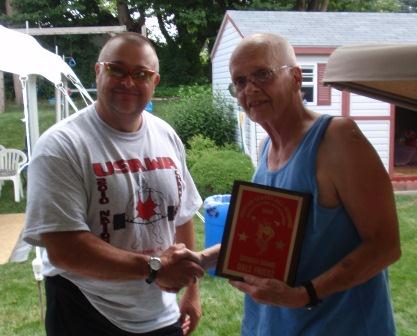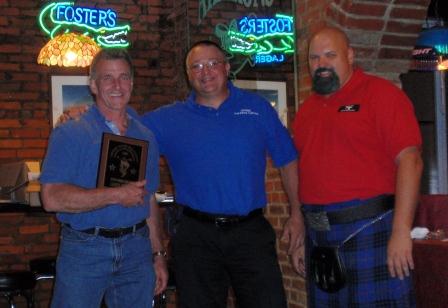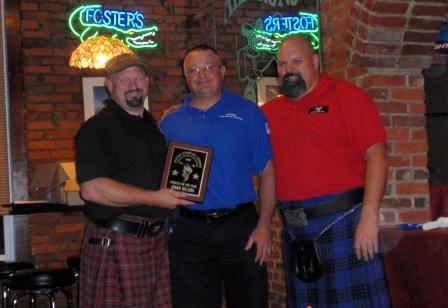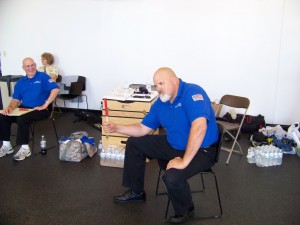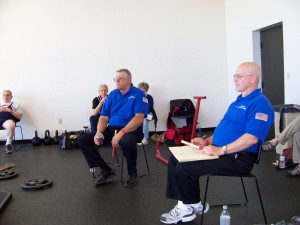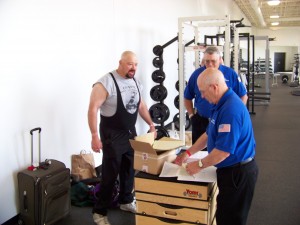by Thom Van Vleck
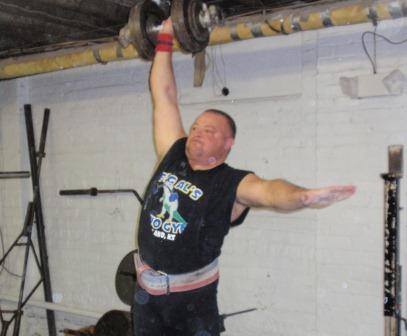
USAWA Secretary Al Myers has the top Dumbbell Snatch in the Record List with this 146# lift at the 2010 Club Challenge.
Let’s take a look at the Dumbbell Snatch which is one of the lifts contested at the 2011 USAWA Nationals being held by the Jackson Weightilifting Club in Kirksville, Missouri on June 25th. I have listed three rules because one references the other. If you want the “quick” version, scroll down!
E18. Snatch – Dumbbell, One Arm
The rules of the Bar Snatch – One Arm apply except one evenly loaded dumbbell is used. The dumbbell may start at any position on the platform. The dumbbell is allowed to rotate during the lift and may finish in any degree of rotation.
A45. Snatch – One Arm
The rules of the Snatch apply with these exceptions. Only one arm is used to perform the lift. The bar is gripped in the center with one hand using any grip, but the palm of the hand must be facing the lifter at the beginning of the lift. The non-lifting hand may be braced or supported on the thigh or knee of either leg but must not contact the bar, platform, or lifting arm during the lift or it will be a disqualification. The non-lifting hand must be clear of the body upon completion of the lift. The bar may be in any degree of rotation during the lift and upon the finish of the lift. Once the bar is overhead motionless, the lifter’s body in an upright position, the lifting arm straight with a locked elbow, the feet parallel and in line with the torso, an official will give a command to lower the bar. The lift ends when the bar is returned to the platform under control. It is acceptable to use two hands in lowering the bar.
D. Snatch
The bar will be placed on the platform, in front of the lifter’s feet. The lifter will grip the bar with the palms of the hands facing the lifter, and then in one single and continuous movement lift the bar overhead to arm’s length. The lifter may choose any width of hand spacing. The lift begins at the lifter’s discretion. The lifter may drop under the bar as it goes overhead, using a squat-style catch in which the legs are bent, or a split-style catch in which the legs are split. The lifter may also choose to drop only slightly, using a power-style catch. The bar may touch the lifter’s thighs and body during the lift. The feet may move during the lift. No other part of the body other than the feet may touch the platform during the lift. The turning over of the wrists must not take place until the bar has passed the top of the lifter’s head. The bar must not touch the head, stop, or be pressed as it goes to an overhead position. The lifter will recover and stand when ready, from the squat or split position, to an upright standing position. The bar must be maintained in a final motionless position overhead, with arms and legs fully extended, and the feet parallel and in line with the torso. At this time, a command from an official is given to return the bar to the platform. The lift ends when the bar is brought back to the platform under control by the lifter.
WOW! Did you get all that! Here’s the short version:
Grip the dumbbell and take it overhead in one movement and catch it at arms length with the elbow locked, no press out. You can drop under it anyway you want as long as nothing touches the floor but your feet. The free hand may brace against the thigh or torso but may not touch the other hand and once you recover, this is important, the free hand must be away from the body. Finally, you can go left or right handed, your choice at Nationals!
